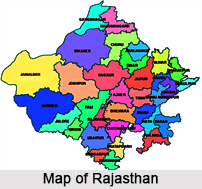 Demography of Rajasthan shows according to the 2011 census, which stands out at about 68 million, making it the 8th most populated state in India.
Demography of Rajasthan shows according to the 2011 census, which stands out at about 68 million, making it the 8th most populated state in India.
Percentage of Population in Rajasthan
Rajasthan makes up about 5.6% of the country`s population a figure which was about 5.4% during the last census in 2001. The state is spread over an area of about 340000 sq. km. making it the largest state in the country in terms of area.
Population Density of Rajasthan
The density of population per sq. Km. is about 200 and a lot below the national average. The state has a growth rate of about 21 percent which is the 11th highest growth rate in the country. The population of the state is rising considerably due to rapid efforts towards development and progress. The literacy rate in the state is about 67% which is a cause for concern and a statistic the authorities must take notice of and look to correct in the years to come.
Sex Ratio of Rajasthan
The sex ratio in Rajasthan also leaves a lot to be desired as it lags behind the national average by 10 points.
Population Statistics in Rajasthan
Rajasthan has population of 6.86 Crores, an increase from figure of 5.65 Crore in 2001 census. The total population of Rajasthan is as per 2011 census at about 68,548,437 of which male and female are 35,550,997 and 32,997,440 respectively. In the year 2001, the total population was 56,507,188 in which males were 29,420,011 while females were 27,087,177. The total population growth in this decade was 21.31 percent while in previous decade it was 28.33 percent. The population of Rajasthan forms 5.66 percent of India in 2011. In 2001, the figure was 5.49 percent.
Literacy Rate of Rajasthan
The literacy rate in Rajasthan has seen upward trend and is 66.11 percent as per 2011 population census. Of that, male literacy stands at 79.19 percent while female literacy is at 47.76 percent. In 2001, literacy rate in Rajasthan stood at 60.41 percent of which male and female were 70.32 percent and 43.85 percent literate respectively.
Population Density of Rajasthan
The total area of Rajasthan is 342,239 sq. km. The population density of Rajasthan is 200 per sq km which is lower than national average of 382 per sq km. In 2001, the population density of Rajasthan was 165 per sq km, while national average in 2001 was 324 per sq km.



















